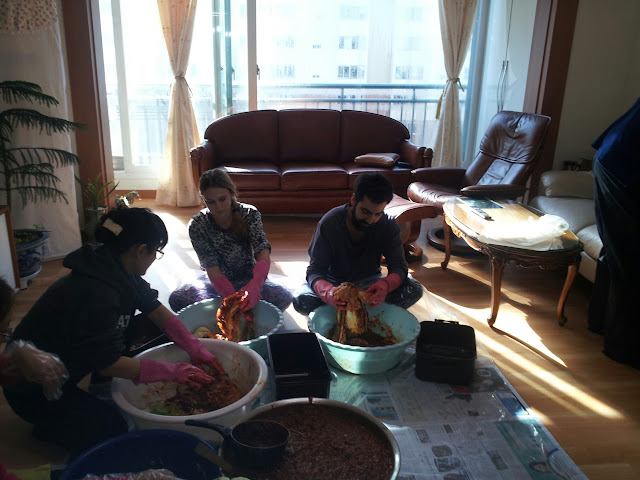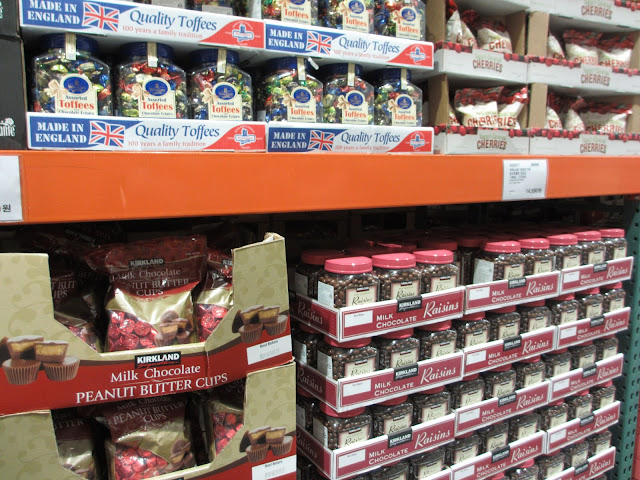Kimchi is the national food of Korea. It's served at every meal, it's healthy, and it actually goes well with a lot of other foods. What is kimchi?
 |
| These are all types of kimchi! Photo by Joel McConvey for The Walrus magazine. |
Kimchi is a combination of fermented vegetables, red chili peppers, and a seafood-based sauce. The type of vegetable varies depending on the type, but the most common variety is 'baechu kimchi,' made with Napa cabbage (baechu) and the chili/seafood sauce mix. In the summer, white radish kimchi soup and cucumber kimchi soup are both common. There are hundreds of varieties, and not all of them are spicy.
 |
| Cucumber kimchi. Photo and recipe by Soomeenshee. |
 |
| White radish kimchi (mool kimchi) is watery, tart, and served cold in the summer. Photo by Naomi Imatome Yun. |
But that's not all! You don't have to eat kimchi alone. It goes surprisingly well with an equally surprising number of other foods. I've tried kimchi fried rice, kimchi ramen, and I've seen (but not tasted) kimchi porridge. I've seen recipes for kimchi grilled cheese, and a coworker once made kimchi-tuna arepas that were delicious.
 |
| Kimchi grilled cheese from a food truck in Hollywood, FL. I know what I'm having for lunch today! Taken by Carlos at foodspotting.com |
 |
| Kimchi tuna arepas with melted american slices (I refuse to call it cheese) and tomatoes! These looked and sounded weird but were actually really delicious, I had two! |
Anyone who hasn't tasted kimchi before is probably wondering, "So what's the deal with kimchi? Why do people like these hot rotting veggies?" That's what I wanted to know before I came to Korea. Before hopping on a plane to Seoul, my sole experience with Korean food was a high school teacher who brought in his homemade kimchi that he had buried in his backyard in a tupperware container for several months. Yikes.
Kimchi actually has a long and rich history! It was originally made with cabbage and beef stock, and has existed for thousands of years in that form. Red chili peppers, which are ubiquitous in Korea, weren't introduced until the Japanese Invasions of the 1500's. They caught on quickly, and red pepper paste and/or flakes are used in pretty much every food in this country.
 |
| Red pepper powder. This is actually from H-mart, an American grocery chain that caters to Asian markets. Photo by momofukufor2. |
 |
| Many Koreans, especially here in Chuncheon, grow their own stock of red chili peppers on any land they can find. Then they dry them, often on the sidewalk or in public spaces. No biggie, apparently. Photo by John Stenberg. |
 |
| Kimchi pots come in a range of sizes, depending on your kimchi needs. Photo by Gapunzel@flickr.com. |
Why is it fermented? Fermentation is a process that not only preserves foods but actually makes them healthier. Decomposition and fermentation are similar processes with very different products. It's the difference between spoiled milk and cheese, between pickles and rotted cucumbers. Decomposition requires putrefactive bacteria, which break down the matter into inedible and smelly components. Fermentation requires active cultures, such as those found in yogurt, and breaks down the matter into smaller, more easily digestible components. It also helps pack foods with more biotin, nicotinic acid, riboflavin, thiamine and vitamin B12, among other vitamins.
So, in short, fermentation:
- preserves food without spoiling it
- makes it easier to digest
- packs it with healthy vitamins
Fermentation is trending these days, and studies show that eating kimchi (which is chock-full of lactic acid bacteria) is even healthier and better for your digestive system than eating yogurt. Any vegetable can be fermented if you do it properly.
Now, back to gimjang. Gimjang is the process of making kimchi. It's generally done once a year, which means that a family's entire supply of kimchi for the next year is made in one day. I was fortunate enough to be invited to gimjang day with a coworker's family! It was messy, smelly, and delicious. Upon arrival at our coworker's parents' house, we were given work clothes.
 |
| Proper kimjang clothes. I'm wearing ajumma clothes (ajummas = old Korean ladies). Unfortunately for Juan, they didn't have any ajumma clothes for him. They're SO comfy! |
My coworker's mother-in-law had already done most of the preparation before we arrived. She made the kimchi sauce--which is insanely complicated and has tons of ingredients. Each ajumma has her own special recipe. Most young people have never made the sauce, and most don't participate in kimjang day. They simply rely on their parents to make it for them!
 |
| That is a LOT of sauce. And we're going to use all of it. |
Koreans are extremely dependent on their parents--which isn't a criticism, it actually seems pretty awesome. Families seem closer on average in Korea than they do in America. Kids live with their parents until they get married, even if that means until they're in their late thirties. Parents live near or even with their kids, and help take care of the grandkids. Some of my students have siblings that live full-time with the grandparents. It's an interesting family dynamic, and is definitely reminiscent of the old adage about taking a village to raise a child.
That said, most of my coworkers don't know some simple things, like where to buy trash bags, because their parents buy those items. So there are a few cons to this system.
Anyway, back to gimjang. The two things we need now are the chili-sauce and the cabbages. The cabbages are soaked in a brine (saltwater) solution, which makes them salty and limp. The salt allows the cabbages to ferment rather than simply rot. Many families do gimjang outside because it's messy, but our family covered the floor in newspaper and a tarp.
 |
| That's not all the cabbages, just the first tub. |
 |
| Action pose, Juan! Everybody gets an empty tub. |
Next we sit, scoop a glob of sauce into our individual tubs, and add a few cabbages. We get big rubber gloves because this is messy business! Each individual leaf must be separated and coated in sauce. Use too much sauce and the kimchi will be too salty. Use too little sauce and it will taste bland. Juan and I were definitely feeling the pressure to not screw up a family's entire kimchi supply for the next year, so we worked hard.
 |
| The raw ingredients. |
 |
| Getting to work! |
Saucing up the cabbage is a lot like painting. I was told that I was a natural but that could have just been them being nice. It was relaxing!
 |
| Natural or not, I think I did okay. |
The saucy cabbages are carefully stacked into the black bins, which are lidded and placed in the special kimchi fridge to ferment. Because trust me, they are STINKY.
Once we ran out of cabbages, we still had some sauce left over. We threw anything and everything in. Frankly I'm not sure what most of it was. I know one tub made fresh kimchi with the fallen-off bits of cabbage and fresh raw oysters. We got a bag of that to take home, and a Korean pear! Yum!
After making kimchi, we were treated to an amazing home-cooked meal: slow-cooked fatty pork and a mudfish soup. Mudfish soup is a special delicacy, apparently, and my coworker's mother-in-law was up all night making it. While I thought the pork was incredible, I wasn't a fan of the special soup, mostly because it had ground-up bits of fish bones in it.
It was an excellent day and I'm happy to report that our takeaway kimchi is delicious. I don't have a dedicated separate kimchi fridge, and I wasn't about to put the kimchi in with the rest of my food, so it's currently sitting between the outer and inner windows of my kitchen, where it'll stay nice and cold. I'm so thankful to my coworker and his family for giving us such a cool cultural experience! Now I just need to learn to make some sauce and I'll be able to make my own kimchi when I get home... maybe.
One week to go until I meet my family in Fiji. Soon this blog will return to its roots: fish, algae, and nudibranch photos. I can't wait!
Cheers,
Ashton
 |
| The floor was heated, which was nice. My motto is "a warm bum is the secret to a happy life." |
 |
| Our sauce supply is dwindling! |
Once we ran out of cabbages, we still had some sauce left over. We threw anything and everything in. Frankly I'm not sure what most of it was. I know one tub made fresh kimchi with the fallen-off bits of cabbage and fresh raw oysters. We got a bag of that to take home, and a Korean pear! Yum!
 |
| Noodles? I have no idea. |
 |
| Bagging up some fresh kimchi for us helpful waygukin (foreigners)! |
After making kimchi, we were treated to an amazing home-cooked meal: slow-cooked fatty pork and a mudfish soup. Mudfish soup is a special delicacy, apparently, and my coworker's mother-in-law was up all night making it. While I thought the pork was incredible, I wasn't a fan of the special soup, mostly because it had ground-up bits of fish bones in it.
It was an excellent day and I'm happy to report that our takeaway kimchi is delicious. I don't have a dedicated separate kimchi fridge, and I wasn't about to put the kimchi in with the rest of my food, so it's currently sitting between the outer and inner windows of my kitchen, where it'll stay nice and cold. I'm so thankful to my coworker and his family for giving us such a cool cultural experience! Now I just need to learn to make some sauce and I'll be able to make my own kimchi when I get home... maybe.
One week to go until I meet my family in Fiji. Soon this blog will return to its roots: fish, algae, and nudibranch photos. I can't wait!
Cheers,
Ashton









































